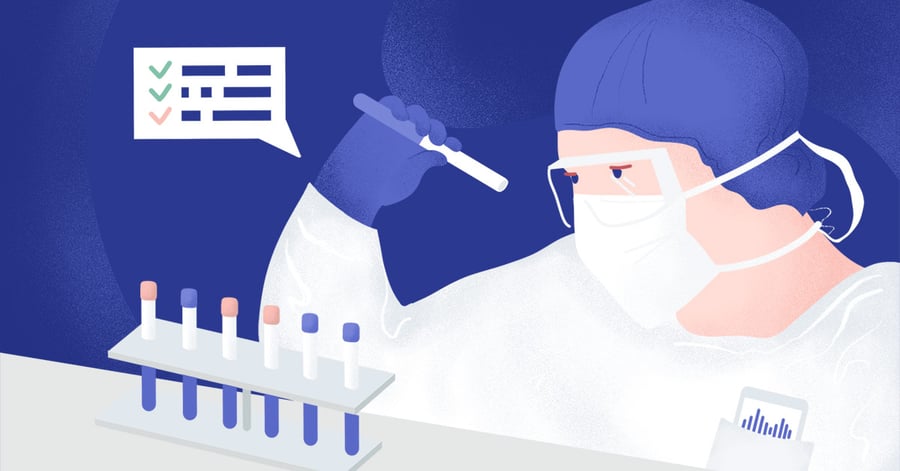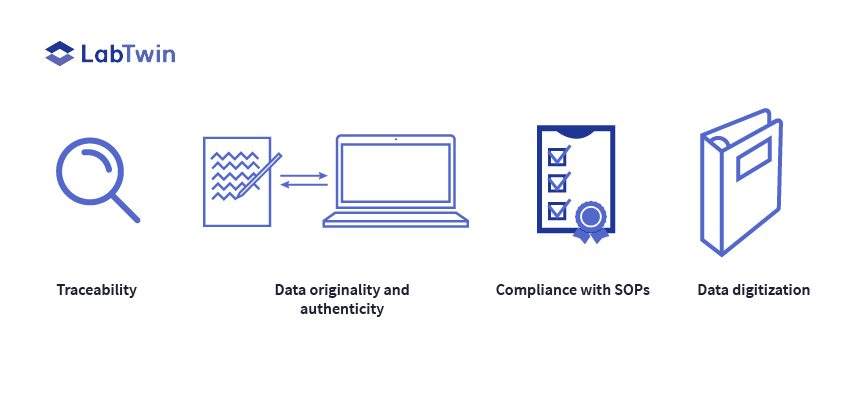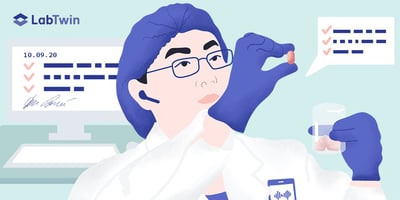Any company manufacturing drug products, biologics or medical devices must follow current Good Manufacturing Practice (cGMP) regulations. These regulations ensure that medical products are safe and effective for patients and consumers. cGMP regulations are enforced by a number of regulatory agencies around the world, including the U.S. Food and Drug Administration (FDA) and the European Medicines Agency (EMA).
cGMP regulations include minimum standards for all facilities, equipment, processes and quality management systems used to manufacture medical products. LabTwin’s voice-powered digital lab assistant can help companies comply with cGMP requirements, by allowing staff to accurately record manufacturing conditions and processes, in real-time, from anywhere within manufacturing facilities.
Better Record Keeping with Full Audit Trail
Unlike ELN, LIMS and MES software, LabTwin’s digital lab assistant allows real-time data collection by directly communicating with lab equipment, as well as instantly transcribing voice notes. LabTwin lowers data transcription error rates because data are automatically collected at the point of experimentation, with time stamps and electronic signatures.
Easier Validation of Equipment and Processes
With LabTwin’s digital lab assistant, scientists can make real-time data-driven decisions when validating equipment and processes. Instant access to data makes it easier to troubleshoot methods and ensure that equipment and processes perform within acceptable limits.
Automated Equipment Maintenance
LabTwin can automatically connect to lab instruments, making it easy to monitor equipment calibration. The digital lab assistant can also remind staff of essential equipment maintenance schedules to maintain optimal function.
Streamlined SOP Management
Scientists can access SOPs by voice commands with LabTwin’s voice-activated digital lab assistant. LabTwin can also dictate SOPs step-by-step to scientists and record protocol adherence, thus improving compliance and facilitating auditability. The digital lab assistant also makes it easy to update protocols in real time, and record any protocol deviations, thus ensuring that all staff use the most up-to-date and validated SOPs.
Facilitated Staff Training and Competency
The digital lab assistant can identify users and track use of SOPs and other training documents. These features make it easy to record staff training and monitor staff competency.
Improved Compliance
LabTwin makes it easier to record and manage data for all aspects of manufacturing. This results in improved record keeping with complete traceability. Combined with time stamps and electronic signatures, this provides a full audit trail.
Conclusion
Any manufacturer wishing to market medicines or drug products within the U.S or the E.U. must comply with cGMP regulations. LabTwin’s voice-activated digital lab assistant helps with cGMP compliance by allowing companies to accurately record data and manufacturing conditions. With LabTwin, companies can manage equipment and process validation, SOP compliance, staff training and quality control processes.
Documentation challenges in cGMP environments

Case: Sample Preparation
Poor quality samples lead to poor quality assay results. Therefore, sample collection and preparation methods are a critical part of current Good Manufacturing Practice (cGMP). Documentation and data integrity are also essential components of cGMP. Data integrity, as defined by regulatory agencies such as the U.S Food and Drug Administration (FDA), means data must be complete, original, accurate, contemporaneous and attributable.
However, it is impossible for a scientist to fully concentrate on sample preparation and, at the same time, make a complete and accurate record of everything they did to prepare that sample. This is especially true for complicated sample preparation protocols where the end product is prone to degradation, such as RNA extraction. 
Technicians must wear gloves to protect themselves and the sample from contamination. Work with potentially infectious material must also take place in a biosafety cabinet. All these factors make it difficult to generate contemporaneous, accurate and complete records of cGMP activities.
Technicians may have to leave their samples on the bench and remove their gloves in order to record data on paper, or enter data into a manufacturing execution system (MES) or Laboratory Information Management System (LIMS). MES and LIMS are often on computers located away from the bench. This disconnect can significantly disrupt workflow during sample preparation, compromising the quality of both the sample and associated data.
If scientists choose instead to complete sample preparation and then update records at a later time, the data is no longer contemporaneous.
With voice-activated digital lab assistants, technicians can follow protocols, make notes and collect data while they work at the bench. Digital lab assistants make it possible to create truly contemporaneous, complete, accurate and original records during cGMP manufacturing. Technicians can concentrate on their work, knowing their voice notes are automatically digitized and attributed with user identification and time and date stamps.
In the Lab of the Future, digital assistants will also connect with all lab instruments and automatically note critical metadata including lab temperature and humidity, and reagent identification, weights and batch numbers. This will allow technicians and managers to monitor how conditions affect sample and product quality.
Want to learn more about how LabTwin can overcome documentation challenges in GMP environments? Read further:
Using Voice Entry to Increase Data Integrity in GMP Sample Preparation [White Paper]
Microbiological Testing in cGMP-environment with LIMS and MES software [White Paper]
The Impact of Digital Lab Assistants on Good Manufacturing Practices (cGMP) and Data Integrity [White Paper]
References
U.S Food and Drug Administration Current Good Manufacturing Practice (CGMP) Regulations (Online) Accessed April 30, 2020 at https://www.fda.gov/drugs/pharmaceutical-quality-resources/current-good-manufacturing-practice-cgmp-regulations
U.S Food and Drug Administration Facts About the Current Good Manufacturing Practices (CGMP) (Online) Accessed April 30, 2020 at https://www.fda.gov/drugs/pharmaceutical-quality-resources/facts-about-current-good-manufacturing-practices-cgmps
U.S. Food and Drug Administration Quality System (QS) Regulation/Medical Device Good Manufacturing Practices (Online) Accessed April 30, 2020 at https://www.fda.gov/medical-devices/postmarket-requirements-devices/quality-system-qs-regulationmedical-device-good-manufacturing-practices
European Medicines Agency Good Manufacturing Practice (Online) Accessed April 30, 2020 at https://www.ema.europa.eu/en/human-regulatory/research-development/compliance/good-manufacturing-practice











